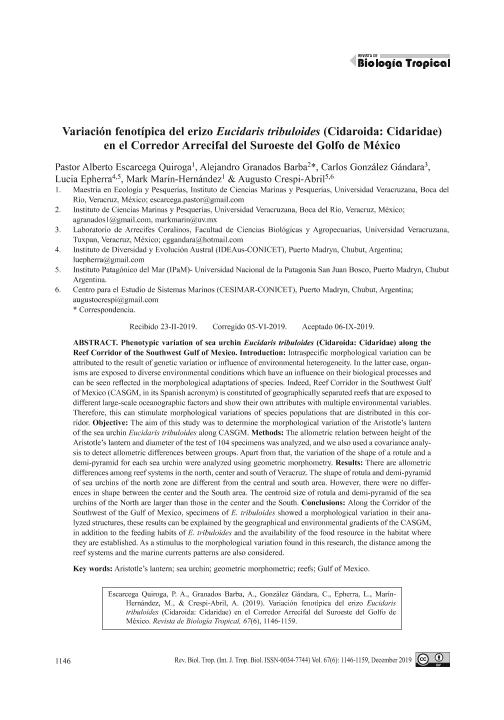Mostrar el registro sencillo del ítem
dc.contributor.author
Escarcega Quiroga, Pastor
dc.contributor.author
Granados Barba, Alejandro
dc.contributor.author
Gonzalez Gandara, Carlos
dc.contributor.author
Epherra, Lucía

dc.contributor.author
Marin-Hernandez, Mark
dc.contributor.author
Crespi-Abril, Augusto César
dc.date.available
2020-12-02T19:43:08Z
dc.date.issued
2019-12
dc.identifier.citation
Escarcega Quiroga, Pastor; Granados Barba, Alejandro; Gonzalez Gandara, Carlos; Epherra, Lucía; Marin-Hernandez, Mark; et al.; Variación fenotípica del erizo Eucidaris tribuloides (Cidaroida: Cidaridae) en el Corredor Arrecifal del Suroeste del Golfo de México; Revista de Biología Tropical; Revista de Biología Tropical; 67; 6; 12-2019; 1146-1159
dc.identifier.issn
0034-7744
dc.identifier.uri
http://hdl.handle.net/11336/119660
dc.description.abstract
Introduction: Intraspecific morphological variation can be attributed to the result of genetic variation or influence of environmental heterogeneity. In the latter case, organisms are exposed to diverse environmental conditions which have an influence on their biological processes and can be seen reflected in the morphological adaptations of species. Indeed, Reef Corridor in the Southwest Gulf of Mexico (CASGM, in its Spanish acronym) is constituted of geographically separated reefs that are exposed to different large-scale oceanographic factors and show their own attributes with multiple environmental variables. Therefore, this can stimulate morphological variations of species populations that are distributed in this corridor. Objective: The aim of this study was to determine the morphological variation of the Aristotle’s lantern of the sea urchin Eucidaris tribuloides along CASGM. Methods: The allometric relation between height of the Aristotle’s lantern and diameter of the test of 104 specimens was analyzed, and we also used a covariance analysis to detect allometric differences between groups. Apart from that, the variation of the shape of a rotule and a demi-pyramid for each sea urchin were analyzed using geometric morphometry. Results: There are allometric differences among reef systems in the north, center and south of Veracruz. The shape of rotula and demi-pyramid of sea urchins of the north zone are different from the central and south area. However, there were no differences in shape between the center and the South area. The centroid size of rotula and demi-pyramid of the sea urchins of the North are larger than those in the center and the South. Conclusions: Along the Corridor of the Southwest of the Gulf of Mexico, specimens of E. tribuloides showed a morphological variation in their analyzed structures, these results can be explained by the geographical and environmental gradients of the CASGM, in addition to the feeding habits of E. tribuloides and the availability of the food resource in the habitat where they are established. As a stimulus to the morphological variation found in this research, the distance among the reef systems and the marine currents patterns are also considered.
dc.format
application/pdf
dc.language.iso
spa
dc.publisher
Revista de Biología Tropical

dc.rights
info:eu-repo/semantics/openAccess
dc.rights.uri
https://creativecommons.org/licenses/by/2.5/ar/
dc.subject
ARISTOTELES LANTERN
dc.subject
SEA URCHIN
dc.subject
GEOMETRIC MORPHOMETRIC
dc.subject
REEFS
dc.subject
GULF OF MEXICO
dc.subject.classification
Ecología

dc.subject.classification
Ciencias Biológicas

dc.subject.classification
CIENCIAS NATURALES Y EXACTAS

dc.title
Variación fenotípica del erizo Eucidaris tribuloides (Cidaroida: Cidaridae) en el Corredor Arrecifal del Suroeste del Golfo de México
dc.title
Phenotypic variation of sea urchin Eucidaris tribuloides (Cidaroida: Cidaridae) along the Reef Corridor of the Southwest Gulf of Mexico
dc.type
info:eu-repo/semantics/article
dc.type
info:ar-repo/semantics/artículo
dc.type
info:eu-repo/semantics/publishedVersion
dc.date.updated
2020-07-20T19:29:32Z
dc.journal.volume
67
dc.journal.number
6
dc.journal.pagination
1146-1159
dc.journal.pais
Costa Rica

dc.journal.ciudad
Turrialba
dc.conicet.avisoEditorial
Revista de Biología Tropical is a Full Open Access journal of the University of Costa Rica aimed at specialized personnel in the fields of Biology and Conservation. It has been published since 1953 and has both electronic and printed editions.
dc.description.fil
Fil: Escarcega Quiroga, Pastor. Universidad Veracruzana; México
dc.description.fil
Fil: Granados Barba, Alejandro. Universidad Veracruzana; México
dc.description.fil
Fil: Gonzalez Gandara, Carlos. Universidad Veracruzana; México
dc.description.fil
Fil: Epherra, Lucía. Consejo Nacional de Investigaciones Científicas y Técnicas. Centro Científico Tecnológico Conicet - Centro Nacional Patagónico. Instituto de Diversidad y Evolución Austral; Argentina. Universidad Nacional de la Patagonia "San Juan Bosco". Facultad de Ciencias Naturales - Sede Puerto Madryn. Instituto Patagónico del Mar; Argentina
dc.description.fil
Fil: Marin-Hernandez, Mark. Universidad Veracruzana; México
dc.description.fil
Fil: Crespi-Abril, Augusto César. Universidad Nacional de la Patagonia "San Juan Bosco". Facultad de Ciencias Naturales - Sede Puerto Madryn. Instituto Patagónico del Mar; Argentina. Consejo Nacional de Investigaciones Científicas y Técnicas. Centro Científico Tecnológico Conicet - Centro Nacional Patagónico. Centro para el Estudio de Sistemas Marinos; Argentina
dc.journal.title
Revista de Biología Tropical

dc.relation.alternativeid
info:eu-repo/semantics/altIdentifier/doi/http://dx.doi.org/10.15517/RBT.V67I6.36319
dc.relation.alternativeid
info:eu-repo/semantics/altIdentifier/url/https://revistas.ucr.ac.cr/index.php/rbt/article/view/36319
Archivos asociados
